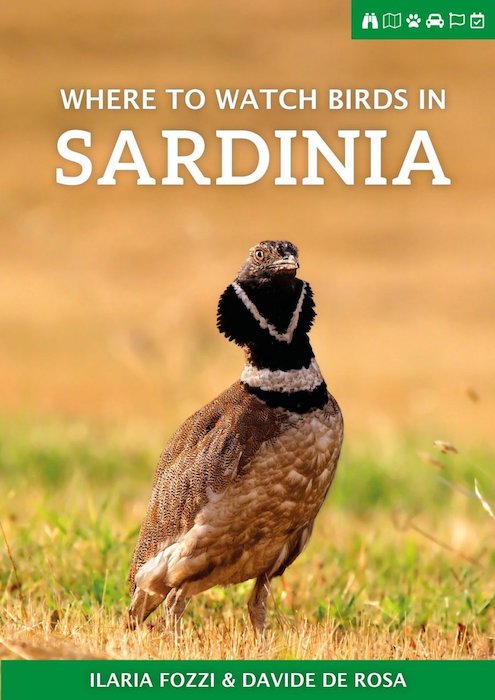Where to Watch Birds in Sardinia
By Ilaria Fozzi & Davide De Rosa | Pelagic Publishing | 2018 | Paperback | 140 pages, 57 colour photos, 52 b/w maps | ISBN: 9781784271794

Where to Watch Birds in Sardinia
The Publisher’s View: Sardinia is in the middle of the western Mediterranean between Europe and Africa. Its location on the Mediterranean flyway makes it an important refuelling stop for migrating birds – especially on its extensive wetlands. A popular destination for birders and naturalists, Sardinia has a great diversity of fauna and flora, along with rich cultural and historical attractions.
Where to Watch Birds in Sardinia, written by two ornithologists with extensive experience of Sardinian birding, provides detailed information on the 43 key birding sites in Sardinia. For each site the target species are highlighted, along with information on habitat, when to visit, other wildlife, facilities, access, how long you’ll need, the photographic opportunities and recommendations for your visit. A map of each site helps with planning and navigation to the site.
Often described as a micro-continent for the variety of its ecosystems, Sardinia has mountains, forests, lowlands, gorges, wetlands, long sandy beaches and rocky shores. It is home to around 300 bird species, 41 mammals, 18 reptiles and 8 amphibians as well as a hugely diverse invertebrate fauna. Owing to its geographical isolation, altitudinal variation and limited human presence, Sardinia has retained many habitats that are favourable for the development and preservation of a large number of endemic plants, accounting for 10 per cent of the island’s flora and including several orchid species.
Sardinia’s ‘must-see’ birds include Greater Flamingo, Eleonora’s Falcon, Purple Swamphen, Little Bustard, Audouin’s Gull, Marmora’s Warbler, Corsican Finch, Griffon Vulture and Barbary Partridge. In spring, April and May are the best months for migration, while for the autumn migration the best period stretches from the end of August to the end of October. Wetlands are the most important sites in springtime, with many species stopping for some days before going north. During the breeding season these areas are very important for Greater Flamingo, Audouin’s Gull, Little Tern and several other species of waders, gulls and terns. The breeding season is also a good time to see ‘special’ resident species like the Little Bustard in display or to hear the flight call of the Corsican Finch. In winter, large concentrations of ducks and gulls are found on the island, with the occasional vagrant from Siberia or North America.
The Authors: Ilaria Fozzi was born in 1984. After graduating in natural sciences in Sassari, she has worked since 2010 with the Wildlife Observatory of Asinara National Park, in northern Sardinia. She is an apprentice ringer, a data collector for the Italian Ornithological Monitoring and for IWC (International Waterfowl Census). She has collaborated in several bird ringing projects in Italy and abroad.
Davide De Rosa is an ornithologist with particular expertise in the ecology, migration and population dynamics of birds in Italy, especially in southern Italy and Sardinia. In recent years, his studies have focused on Lanner Falcons and Red Kites, and on the impacts of climate change on bird communities. He is also interested in relationships between pollution and the physiology of birds in agricultural landscapes. He is a ringer, a data collector for the Italian Ornithological Monitoring and for IWC (International Waterfowl Census). He has collaborated in several bird ringing projects in Italy and abroad, and organises birdwatching tours in Sardinia.
Fatbirder View: What a truly excellent guide this is. Sardinia is not somewhere I’ve ever really considered a birding destination. However, for those wanting a holiday in the Med it has a lot to offer along with enough southern European species to keep UK birders happy.This slim volume is so well constructed I’d love to see this treatment of other destinations. The pages follow a pattern of divisions into categories such as how long to spend at a site, the target species and photo opportunities among all the usual access details etc. Well drawn simplified maps enhance the experience further as do the illustrative photos. All in all, a great effort!
Buy this book from NHBS Fatbirder
